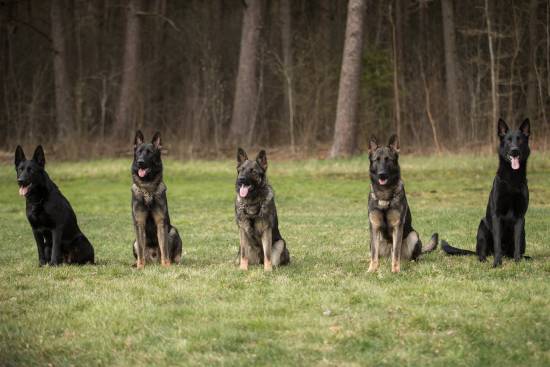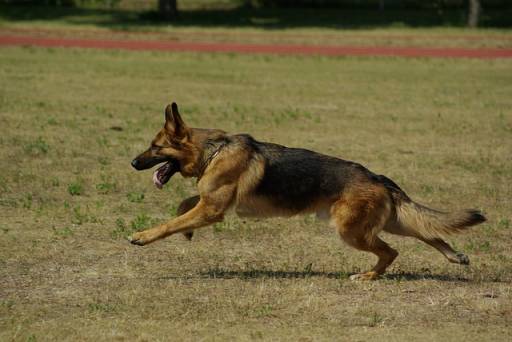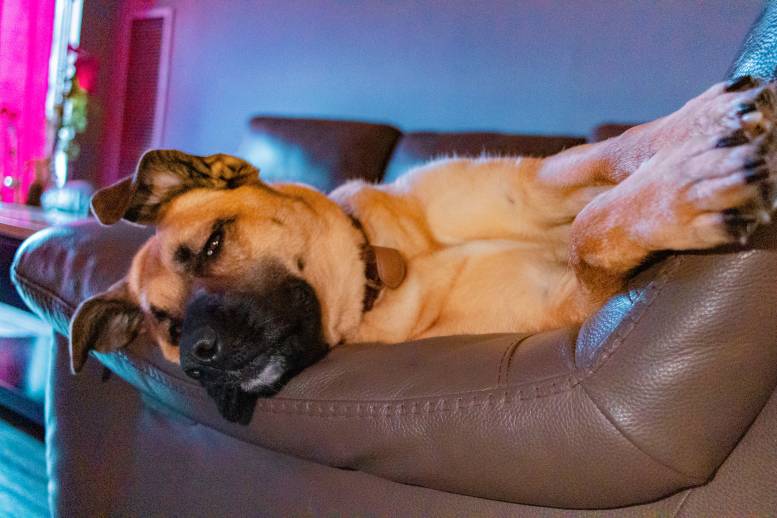Connect with a verified veterinarian in minutes. Licensed vets are available 24/7 to answer your questions. No need to worry about your furry family member.
German Shepherds are one dog breed most people recognize. These are working dogs that have long been a favorite of pet parents around the world.
But did you know there are different types of German Shepherds? If not, then you’ve come to the right place! We’ve put together some information about the breed, its history, the different types of German Shepherds, and more!
What is a German Shepherd?
German Shepherds, also known as Alsatians (in the UK and Europe), are one of the top dog breeds in the US! And it’s one of the most recognized dog breeds in the world. The breed was first developed as a working dog. They were bred to herd cattle; for this reason, the German Shepherd breed is athletic, strong, and full of energy.
These beautiful dogs sport their famous upright ears, a broad head, with a tapered muzzle. The dog’s ears are quite large and stand erect. The German Shepherd has a level back, a muscular body, and a bushy tail that curves down. The breed’s coat is a little bristly and is a medium length; however, there are long-haired German Shepherds, too. What about coat colors? We’ll get to that a bit later!
History of the German Shepherd
The German Shepherd is a fairly new dog breed that was developed back in 1899. The first breeder of these amazing dogs was Captain Max von Stephanitz, who wanted to develop a herding dog. Von Stephanitz took his time in learning to breed dogs. He traveled to Britain and all throughout Germany in the search for excellent herding dogs. He wanted a dog that combined all the best of German herding dogs into one dog: intelligent, capable, and athletic.
During this time, Germany was becoming more industrialized. Von Stephanitz was concerned there would no longer be a “job” for his working dogs. However, he wanted to ensure these dogs would be useful in the future. For this reason, von Stephanitz made the decision to approach the military and police to use his new dog breed. As a result, the German Shepherds were used in WWI in many jobs, including working for the Red Cross, messengers, rescuers, sentry dogs, and more.
It was about this time that German Shepherds also became more popular in the US. A US Allied soldier saw how useful these dogs were during the war and took some dogs back to the US. Do you remember the dog named Rin Tin Tin? This dog was found in a kennel in France during WWI. The kennel had been bombed, but the puppy survived. He was found by an American soldier, who took the puppy home and trained him. This puppy, from war-torn France, became one of the most loved dogs in the US!
While the Germans kept breeding these dogs, the Americans also bred dogs across the pond. The Germans stayed focused on breeding working dogs, while the Americans began to breed the dogs for dog shows. This meant American German Shepherds were being valued more by their looks rather than on how well they worked.
Today, the trend continues with Germans breeding dogs that are bred to work, while Americans tend to focus on breeding German Shepherds for shows and companion dogs. However, even in the US, German Shepherds do continue to work.

Review symptoms, medications & behavior to keep your pets healthy with a Vet Online in just minutes.
Ask a Vet Live NowHow Many Types of German Shepherds Are There?
OK, now we’re ready to take a look at the types of German Shepherds! As noted earlier, the breed was split between German and American breeders. However, the dogs were also bred in other parts of Europe, including then Czechoslovakia (now the Czech Republic) and other countries.
There are basically five types of German Shepherds, which we’ll cover in the following sections.
West-German Working Line German Shepherds
These dogs are first and foremost bred for their temperament and looks. These German Shepherds are thought to be the most closely related to those first bred by von Stephanitz.
Interestingly, these dogs tend to be smaller than other types of German Shepherds primarily used as show dogs. They have a high tolerance to pain and are very hardy. The West German types also have a blended coat pattern, which makes them blend in with the dogs’ surroundings. These dogs are usually a sable or black & tan.
In addition, the West-German dogs also have more energy than some other types of German Shepherds. And they have a stronger prey drive. These dogs are intended to be working dogs and usually aren’t the best companion dogs. They’re highly intelligent and easily become bored, leading to destructive behaviors.
While they can be great family dogs, the West-German Working Line German Shepherds are best for active families and pet parents who know how to handle the dogs.
East German DDR Working Line German Shepherds
East German DDR Working Line German Shepherds are much like their West German cousins. They basically have the same history and the same work ethic (these dogs need to have a job!). The East German type also makes a great watchdog.
These dogs also have a high prey drive, so they should always be monitored around other pets/animals and children. Even so, these dogs have very sweet, docile natures. They are great for pet parents who understand the needs of this German Shepherd type.
The East German DDR Working Line German Shepherds are famous for their endurance and ability to focus. They also have a sable coloring, making them perfect for natural environments.
Czech Working Lines German Shepherds
The Czech Working German Shepherd was developed by Czechs who wanted a hard-working dog. These dogs are a bit lighter than the other German Shepherds, making them more athletic and fast. They have been prized for their high stamina and agility. These dogs may also have a high prey drive, which means it’s necessary to supervise them around kids and other pets/animals.
The Czech Working German Shepherd has the same coloring as the previous two types—black and tan, which is mixed in the dog’s coat. They’ve been described as being more sable or agouti; these colors blend well in natural surroundings.
Czech Working German Shepherds are still bred as working dogs today. However, with the right training and socialization, these can make wonderful family companions. They will still need plenty of exercise and mental stimulation, as well as a pet parent who understands the breed.
American Show Line German Shepherds
American Show Line German Shepherds are some of the most common types of German Shepherd dogs in North America. These shepherds have been bred with other Shepherd types to create a more strong dog with shorter muzzles and heads.
These dogs tend to be black and tan. However, because of being bred with other types, the American German Shepherd can some in a variety of colors. Yet, they are different than European types in that American Shepherds usually have a sloping gait and longer hind legs. The dog’s chest is also broader.
While these are beautiful dogs, American German Shepherds have had a breeding problem. The issue is not with reputable breeders but with puppy mills and backyard breeders. These irreputable breeders have bred dogs that are said to have excellent bloodlines when that’s not the case. The result is dogs with bad temperaments and health problems. Some of the dogs have also developed to be nervous and aggressive, giving this type a bad reputation.
European Show Line German Shepherd
The European Show Line German Shepherd is a beautiful type that has a rich black and rust coat. They have straighter backs (not like the sloped back of the American Show Line German Shepherd).
While these dogs were originally bred from working dogs, today they are calmer and not prey-driven as other types. As a result, the European Show Line German Shepherd makes a great family companion.
This German Shepherd type must meet strict regulations in order to be show dogs. What’s more, they must also pass tests for joints and hips to avoid hip & elbow dysplasia.
Personality Traits of the German Shepherd
German Shepherds were bred to be herding dogs, which means they are extremely intelligent. They are also somewhat aloof but are extremely loyal. A German Shepherd loves his family; however, he will protect them and his property. These dogs are excellent watchdogs.
This dog breed is highly trainable and needs to have a job to do. They can be trained for a wide range of jobs, including helping the blind, visiting the sick, chasing down criminals, searching for illegal substances, search & rescue missions, and so much more.
One thing to understand about German Shepherds is that they don’t do well alone for long periods. If you and your family are away from home for long hours, then this isn’t the dog for you. They need plenty of companionship and exercise.
Without the right amount of exercise and together-time, these dogs are known to develop destructive habits such as chewing. Keep in mind these are powerful dogs; they have the ability to chew up just about anything, including furniture, woodwork, and more. You have to be concerned about more than just chewed-up shoes!
This dog breed requires training and socialization from a young age. German Shepherds are wonderful, well-rounded dogs who can adapt to many situations and people with the right training and socialization.
What about other dogs, pets, and kids? The trained and socialized German Shepherd can make a wonderful companion for kids. They’re also quite protective. However, remember that this is a large, powerful dog that can move very fast. As such, it’s best to never leave young kids alone with a German Shepherd (or any other type of dog).
When it comes to other pets and dogs, German Shepherds can also live very well with them. But the dog must be raised and socialized with other dogs and pets from a young age.
Health of German Shepherds
German Shepherds are usually healthy dogs; however, they can be prone to certain health issues, including:
- Hip dysplasia
- Elbow dysplasia
- Gastric dilatation-volvulus
- Degenerative myelopathy
- Exocrine pancreatic insufficiency
- Allergies
How to Care for a German Shepherd
German Shepherds were bred to be active herding dogs. This means they have a ton of energy and require plenty of daily exercise. Dogs who don’t receive enough exercise to release all that energy will become destructive. These dogs have been known to dig, bark, and chew when bored. So, exercise is imperative for this dog breed.
A German Shepherd needs about two hours of exercise a day at a minimum. The exercise can be divided into different activities such as walks, play-time, and training. It’s best to give these dogs a variety of activity and exercise to keep them from becoming bored.
However, a German Shepherd puppy should never play on hard surfaces until they’re about two years old. The puppies should not run, jump, or play on paved or other hard surfaces. Their joints are still forming and can be easily damaged by hard surfaces. For this reason, it’s best to keep puppies playing in the grass or other soft surfaces.
What to Feed a German Shepherd?
A German Shepherd needs dog food formulated especially for large, active dog breeds. The dog food should contain at least 18% to 22% protein, with a meat listed as the first ingredient on the label.
In addition, it’s best to look for a dog food that’s been developed to meet the guidelines of the AAFCO (Association of American Feed Control Officials). The dog food should contain a badge from this organization, ensuring the food meets their guidelines.
The dog food should also be labeled for “all life stages,” which ensures the food meets the nutritional requirements for all the dog’s life stages from puppyhood to adult. The food should also provide the right nutrients for pregnant and lactating mother dogs.
Summing It Up
German Shepherds are wonderful dogs known for their loyalty and intelligence. No matter which type of German Shepherd you choose, it’s always best to adopt from a reputable breeder.
However, there are plenty of German Shepherds in rescues. These dogs also need and deserve loving fur ever families who will care for them and provide the love they need!
Connect with a verified veterinarian in minutes. Licensed vets are available 24/7 to answer your questions. No need to worry about your furry family member.

Kim
Kim is a talented author, who loves animals especially dogs. She engaged in writing books and articles relating to animals a decade ago. Kim resides in Chicago with her husband and son. The family is the proud owner of a dog and a parrot (Jack and Lily). Kim wanted more than these two pets, but her husband put his foot down... She often visits elementary schools to talk to the kids about what she learned about pets and how they could learn from them.
Review symptoms, medications & behavior to keep your pets healthy with a Vet Online in just minutes.
Ask a Vet Live Now




